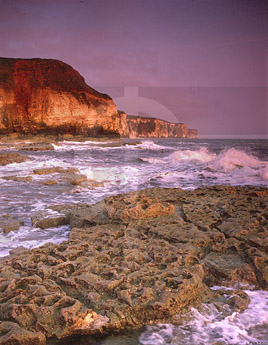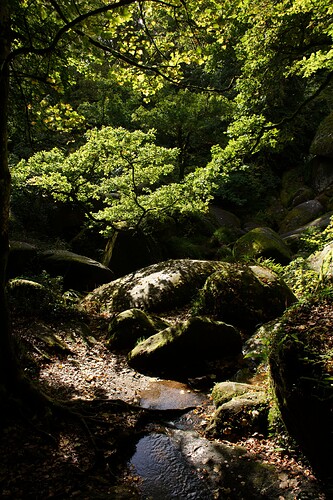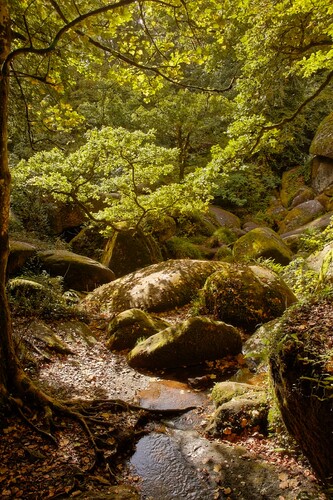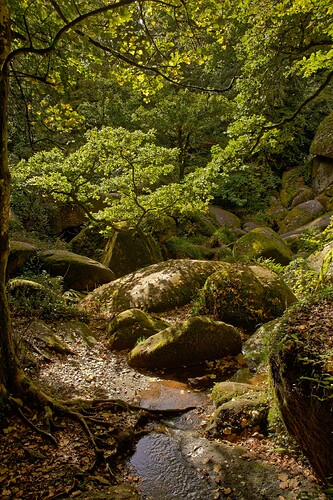I recently bought a FujiFilm GFX100S II camera which includes the standard set of Fuji film simulations. I grow orchids and found that the camera Velvia Film Simulation was the most pleasing. That made me wonder how that would compare to the PL7 Velvia preset. I own FilmPack 6 which has a Velvia50 preset. I also discovered that In the Color/B&W Rendering menu I could select Type: Generic rendering; and Rendering: From camera (Velvia/VIVID (apparently PL7 reads the EXIF data). These two options yield different results, with the Rendering from camera looking a little better. Which is the appropriate setup to use? (Neither simulation looks as good as the version produced by the camera.).
As well as digital, I also practise the dark arts of large format film photography.
Fuji made at least three transparency films of particular interest…
- Astia 100 - this is a beautiful neutral rendering, suited for colour matching scenarios like catalogues and product shots for manufacturing matching.
- Velvia 50 - this was very popular with certain landscape photographers and gave a saturated, but also a browny, purply green rendering that screamed Velvia 50.
- Velvia 100 - this is my preferred film and I still have stock in my freezer. It is quite saturated but not as much as Velvia 50 and it gives a much more “neutral” saturation,
For these reasons, I use the FilmPack Velvia 100 (generic) emulation over any other, as it is remarkably close to its film equivalent.
Not forgetting that, even with film, you can get differences in rendering, depending on the chemistry used to process it.
In believe that in principle, the “Digital Film” renderings should closely match the in-camera film simulations.
But there are many settings (contrast, clear-view, etc etc) that could cause the in-camera JPEGs to differ from the DxO output, some of which might be applied by default. You can tweak the DxO settings to get the result that you like the best and then save this as a preset.
One huge bonus from DxO’s ‘Digital Film’ profiles is that, unlike Lightroom or Capture One, you can use these renderings with any camera, making it easier to match results from different equipment. However, there is still no ‘Reala Ace’ support at the moment.
What I did was take an image of an orchid flower with the GFX100S II and output a HEIC image (with the Velvia film simulation turned on) and a raw (.raf) file. Then I processed the .raf file in PL7 with the Velvia simulations. I compared the camera Velvia simulation (the HEIC image) with the jpg output from PL7. The camera HEIC file was significantly more attractive. The PL7 simulations look over sharpened and over saturated. Now, this is just one image and one orchid flower, but doesn’t inspire me to use the PL7 film simulations. (I have another app - Nitro Photo - with also supports a Velvia preset and it also can’t match the camera image - but in this case it is under-saturated.
This was just an experiment and I don’t expect to process my other camera’s orchid images (I normally shoot my orchids with my OM-1 II - and I am very happy with the color reproduction of that camera.). One interesting feature of the Fujifilm camera is that I can connect it to my Mac with Fuji software and use the camera to “reprocess” raw files with film simulations - I am going to try that for some landscape images with the new camera.
What I’m reading is that you are comparing a straight-out-of-the-camera image with all the associated in-camera settings applied to it, including the film simulation, to a raw file with just the film simulation applied in DxO. Is that correct?
If so, that’s an apples to oranges comparison and it’s not surprising you’re seeing major differences between the two. The quality differences are especially expected if you did not completely finish processing the image in PhotoLab with similar in-camera settings already built into the HEIF file
Mark
If I have to do a lot of post processing of the film simulation presets that makes the simulations less useful. I can start from scratch - with the default PL7 rendering settings (which is very good) and get a “better” image that needs less post-processing! I am not looking for something that makes more work.
David
I think you misunderstood my point. Your HEIF files are completely processed in-camera but raw files are not processed. Just adding a film emulation in post without doing any additional processing will never look like a straight out of the camera processed image. The issue is not the film emulation, it’s the rest of the processing.
Mark
I’m not sure I understand. I probably don’t, but here’s what I do:
I use the GFX100II and I use the Provia Standard setting in camera (which is the standard setting). In PL I mostly use : Type : Generic rendering" and: “Rendering: DxO camera profile (Fuji GFX 100II)”. Sometimes I use “Rendering: From camera (PROVIA/STANDARD”.
Between those 2 settings there is a difference (DxO camera profile is brighter).
However if I go to :Type: Camera Body and then in Rendering choose the Fuji GFX 100II, there is no difference at all between that and "Type: Generic Rendering / Rendering: DxO camera profile (Fuji GFX 100II).
In general, "appropriate " is what you like best.
For example, this shot that I wanted to have the Velvia 100 look that I m used to with LF film.
Here is a straight of the untouched RAW from my Nikon D850…
Here is an export of a fully treated version, using the Fuji Velvia 100™ generic film emulation…
And here is the same treatment, but with the Fuji Velvia VIVE “digital film” emulation…
From vast experience of Fuji films, I can tell you that the middle one is the closest.
But, as Mark says, you will never get this without more work than just selecting the emulation.
Most in-camera emulations just don’t cut it.
By the way, Velvia comes in two flavours 1OO, which I used above; and 50, which my friend Charles used for this…

Notice the purplish cast ![]()
Back in my film days I used Kodak exclusively so I have no memory of what Velvia looked like. I was experimenting with the GFX100S II camera settings for my orchids and the camera Velvia setting looks best. Basically I am going for something between “accurate” colors and “pleasing” colors. I have the orchids right in front of me so I know what they look like.
David
Well, the point of the Fuji presets in Photolab is to mimic the completely processed files from the camera, so I would think that any further processing is optional.
I don’t have a Fuji camera, but Photolab uses some very unfavorable default settings, so it might be possible to come much closer by toning down some of those settings. In the lens module, make sure that sharpening is set to 0 or less and not to the default value 1, which hopelessly oversharpens. Also maybe deactivate smart lightening, clearview and microcontrast. I am not sure if these are activated by default if you use the Fuji preset.
The completely processed files? Clearly we are talking about two different things.
A completely processed SOOC image file from many, if not most modern cameras includes in-camera adjustments for such things as contrast, sharpness, clarity, saturation, hue, chromatic aberration, vignetting, toning, and even noise reduction. Are you suggesting that PhotoLab’s film emulations should include all those raw adjustments in them? I hope not. If so, there is no reason for @HamsterDR to bother shooting raw and he might as well just stick with his out-of-camera HEIF files.
Mark
Thanks for suggestions about adjusting the PL7 defaults. I did notice that the images with the PL7 film simulations looked over-sharpened.
David
I know this is a user forum for an image editing program but my preference is to avoid editing in post as much as possible. (I try to get it right in camera.). My primary use of PL7 is to deal with (very) low light images shot at high ISO values (e.g., nighttime parades). Deep Prime noise reduction and Smart Lighting have been very helpful in recovering those images. The quality of JPEG and now HEIF images has improved dramatically in the past few years. If I expose correctly and I have good light, I don’t need to work with the raw images (I shoot raw+jpeg/heif so I have the raws available if necessary. The Fujifilm GFX100S II MF camera produces beautiful images. Of course that means the camera is making these decisions but I am not bothered by that - I try to take advantage of camera automation when it works. So, I really was expecting the presets to produce a (mostly) completed image. The Fujifilm Velvia film preset also is fine as is. (I have 102 mPix too to work with - so I can crop as much as I want.).
The above notwithstanding, I really appreciate the comments and suggestions. I am strongly considering just moving to Pure Raw which has the key functions I need.
David
Yes, that’s what I would expect, and as you can see from this thread I am not the only one. The advantage of shooting raw does not disappear when you use a picture that is processed in a certain way as a starting point. You are still able to take advantage of the raw file by adjusting it either to your taste or if the file requires it, by profiting from advanced noise reduction, highlight recovery, white balance adjustments in case your camera got it wrong etc.
In your line of argumentation, presets should not exist at all, instead we should always start from an image as neutral as possible.
It’s what I’d hoped for when I bought photolab first. At least for color rendering. But I found their camera emulation is far from what target camera produce (at least with my nikon gear - whatever picture control used).
And I would have hope that white balance react far much closer to their target cameras too.
Which is not the case. It’s perhaps one of the most difficult demosaicer to achieve neutral results with.
Here my second wish is defeated : a neutral possible starting point.
Some will tell all that is so subjective that it has no sense and that retro engeenering what camera manufacturers do can’t be perfect.
For me color rendering is the most difficult part of photolab in many cases.
Or do you?
I also work with wide dynamic range shooting at concerts. And this is where RAW images come into their own.
JPEG images are recorded in only 8 bits, whereas RAW images are typically recorded in 14 bits. Which doesn’t sound like a big difference, until you realise that each raising in power is doubling the number of levels of grey/tonality that can be differentiated.
So, 8 bits can differentiate 256 levels, but 14 bits can differentiate 16,384 levels. The result being that tonal transitions are much smoother and, if necessary, post processing can increase contrast without as much fear of posterisation.
Velvia 100 film is only capable of coping with 5 stops of exposure range, after which, it requires the use of graduated filters to bring highlights into range whilst avoiding blocked shadows.
One gets used to such limitations with film cameras because it is not possible to “post-process” E6 film.
in theory, JPEG images can cope with 8 stops but each tonal level is a discrete step, with no intermediate tones available unless post processing is applied. Whereas, film records continuous tones, so it is able to record those tones that might get altered in the digitisation process.
RAW is a best compromise in that it can differentiate more and smaller steps in tonal value, thus giving smoother images and better detail in tones that are similar.
Since PhotoLab contains everything that PureRAW contains, why would you do that? Yes, you would have a de-mosaïced TIFF image, but that then precludes being able to change any of the RAW parameters, should you feel they need changing in the light of other changes made.
I agree with @mwsilvers - if you are happy with the OOC JPEGs, don’t bother using RAW, but you will surely need some kind of post processing at some time.
Hasn’t photolab more tweakable parameters than pureraw for what pureraw do ?
Which is why I personally think, if you have PhotoLab already, it’s certainly not worth downgrading to PureRAW.
Seems pureraw only has presets (like low - medium -high) when photolab has sliders with continuous values to tweak (I don’t have pureraw).


